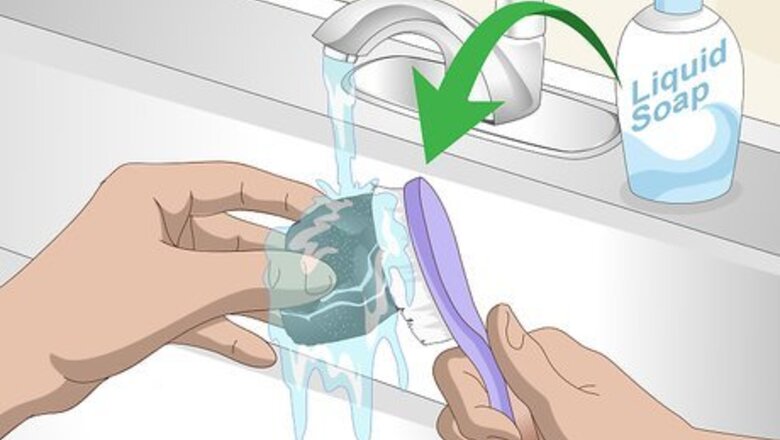
views
Hand Polishing Rocks With Sandpaper
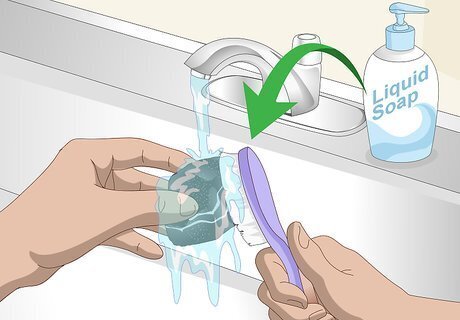
Clean the rock with hot, soapy water. Choose any rock you wish to polish and fill a bucket with hot water and liquid soap. Wash the rock thoroughly with a scrub brush or old toothbrush to remove any stubborn dirt or debris from the crevices. Rinse the rock off with fresh water and pat it to dry. While you can polish any stone you wish, it’s easier to polish a softer stone like onyx, limestone, or calcite. Stones that are very hard take longer to polish, though they yield more shine than softer rocks. To tell if a stone is soft, scratch it with another rock. If the scratch looks chalky, the stone is soft. Also, try to pick a rock with a roundish shape, without major protrusions or indentations. This will make the sanding and polishing process easier.
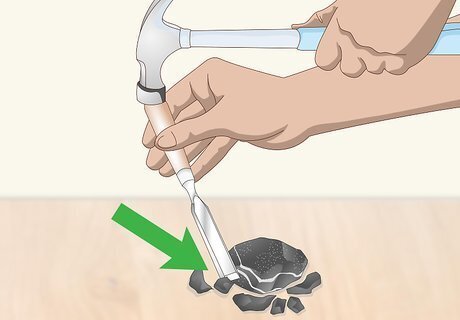
Chip off jagged edges with a hammer (optional). If you want your rock to be rounder before you polish it, use a small hammer or a chisel to chip away at the stone. Chip at any outcroppings or sections that jut out. Put on safety glasses to protect your eyes from chipped pieces and wear safety gloves so you don’t scratch or cut your hands. If you’re happy with the shape of the rock, you can skip this step. If you don’t want to use a chisel or hammer, rub the stone over a slab of concrete to break off any protrusions.
Round the corners with 220-grit sandpaper. Moisten the sandpaper and place it grit-side up on a cutting board. Wet the rock and rub it along the sandpaper to remove hard edges. Continuously wet the rock to remove fine particles, and continue sanding until the edges are smooth and rounded or you achieve your desired shape. If you need to shape a harder rock, opt for coarser sandpaper like 80-grit. Keep in mind that coarse sandpaper shouldn’t be used on soft rocks as it could add more scratches rather than remove them. Remember, the lower the number, the coarser the sandpaper. 50-grit is the roughest grade of sandpaper and works well to shape particularly hard rocks. If you do use a coarse sandpaper that leaves scratches, you can go over them with a finer sandpaper to erase them.
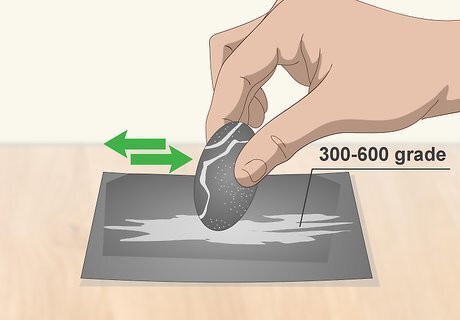
Refine the shape and sand with 300- to 600-grit sandpaper. Use a finer sandpaper in this range to remove noticeable scratches and further refine the shape of your rock. Keep the rock wet throughout the sanding process to achieve better results.
Use 1200-grit sandpaper to remove light scratches and create shine. Use extra-fine sandpaper like the 1200-grit to buff any tiny scratches that remain. As you sand, you should notice some shine forming on your rock’s surface. Continue wetting the rock during this step to expose any rough areas you might have missed.

Rub the stone with a piece of leather and rock polish. Grab a sheet of leather or another thick cloth material and add a couple dabs of tube polish. Rub the leather and polish onto the rock to give it a beautiful, lustrous shine. Make sure you don’t buy colored polish, as it may stain the stone. Alternatively, you can dab some toothpaste onto a thick, cloth fabric like denim and rub it on the stone to create a luster. Depending on the rock, you may need to add more toothpaste several times to get the desired effect. Once you’re done, rinse the rock and coat it with mineral oil or a commercial rock polish. Similarly, you can also try dabbing a bit of car wax onto a rag, then rubbing the rock with it. Only use a little bit at a time and add more wax as necessary.
Alternatively, use a Dremel to polish rocks more quickly. A Dremel is a motorized rotary tool that can quickly grind and shape the edges of hard stones. When you reach the sanding process, you’ll place a sandpaper attachment on your Dremel bit to smooth and shape the rock to your preference. Then, switch the sandpaper out for a polishing wheel, coat it in a rock polishing compound, and buff the rock’s surface. When using a Dremel, always wear protective goggles, a face mask, and gloves to protect yourself from breathing in rock dust or getting injured by flying rock pieces. Dremels work well if you want quick results, a perfectly smooth or round rock, or for hard rocks that would be difficult to polish by hand.
Using a Rock Tumbler
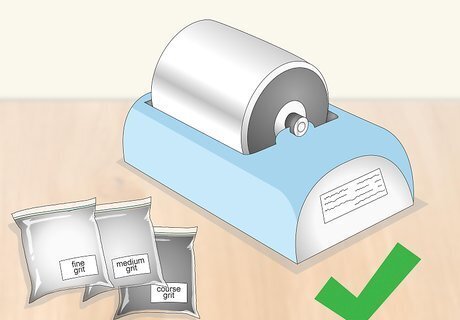
Buy a rock tumbler and coarse, medium, and fine grit. Rock tumblers are great for rock polishing because they give the rock a more defined shine than hand-polishing, and they can polish dozens of rocks at once. To use a rock tumbler, you’ll also need grit designed for rock polishing in coarse (80 grit), medium (220 grit), and fine (400 grit) grinds. You can purchase rock tumblers and grit online from speciality sites or Amazon. Keep in mind that rock tumbler prices vary dramatically, so buy one in accordance with your needs. A cheap, plastic tumbler is a good option if you only want to use it a few times, or spring for a more expensive one if you want to take up rock polishing as a hobby.
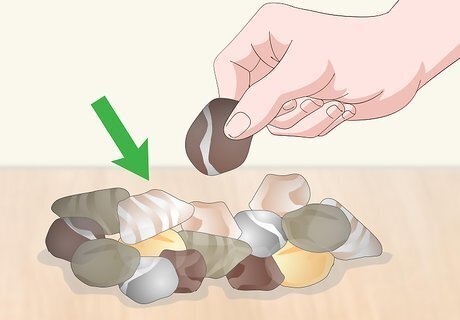
Select and sort your rocks by shape and hardness. Before you start polishing your rocks, sort them so that the rocks you put into the tumbler are of similar hardness and surface shape. You don’t want to put rocks of different hardness in the tumbler because the harder rocks will wear down and scratch the softer rocks. If you put in differently shaped rocks, with some being jagged and others round, the rounder rocks will get polished faster than the irregular ones. However, you should put in rocks of various sizes. This will help the rocks achieve a more uniform shaping. You can use a cabbing machine if they are dome top, flat bottom Cabochons, or use a flat lap, or lapidary wheel, for faceted stones.
Wash the rocks with soap and water. Fill a bucket with warm water and liquid soap (dish soap should be fine). Scrub the rocks with a scrub brush or old toothbrush, paying careful attention to deep crevices. Once all the dirt and debris has been removed, rinse them with fresh water and pat them dry.
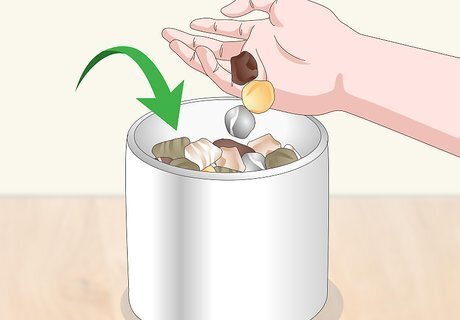
Weigh the rocks and fill the tumbler ½ - ¾ full. Once your rocks have been washed and sorted by hardness and shape, weigh them on a scale to determine how much grit you’ll need (usually 0.1 pound of grit for every pound of rocks). After weighing them, place the rocks back into the tumbler and make sure it’s somewhere between ½ and ¾ of the way full.

Run the tumbler with coarse grit for 3-7 days. Measure out 0.1 pound of grit for every pound of rocks in the tumblr. Then, pour water into the tumbler until it reaches the bottom of the top layer of rocks. Seal the lid of the tumbler and turn it on. Run the tumbler for 24 hours, then open it to check on the progress of the rocks. Put the lid back on and start the tumbler again. Tumble the rocks for 3 to 7 days, checking every 24 hours to make sure that everything is going smoothly. The coarse grit is meant to smooth out the shape of the rocks. For rounder rocks, it should only take about 3 days to get a nice shape. For more jagged rocks, it may take up to 7 to even the surface out. After checking on the rocks every 24 hours, you may decide that they are ready for the next step or that you want to keep tumbling for another day.
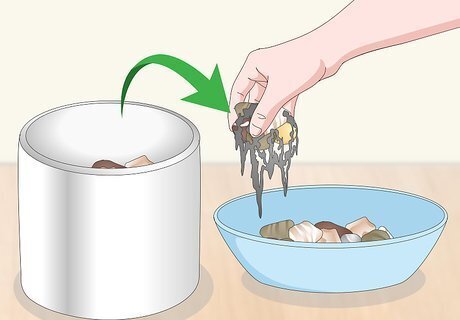
Take the rocks out of the tumbler and clean out the grit. After 3-7 days, take the rocks out of the tumbler and place them in a pan. Clean the grit off of the rocks and the inside of the tumblr. Rinse the rocks and the tumbler right away to prevent the grit from solidifying. Use an old toothbrush to scrub away the grit and any remaining rock particles in the tumbler. It isn’t necessary to use soap. Don’t wash the grit down the sink because it will solidify and clog your drain! Instead, throw it in the garbage. Thoroughly wash your rocks and the tumbler until they are spotless. Having even small amounts of coarse grit left over can disrupt the next part of the process.
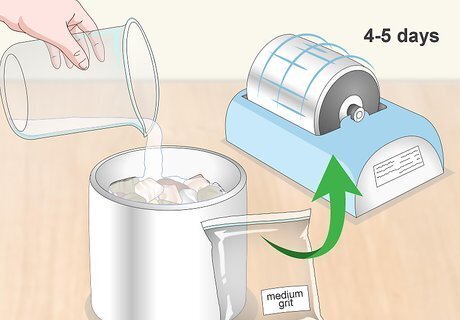
Run the tumbler with medium grit for 4-6 days. Place the clean rocks back in the tumbler and put in the same amount of medium grit as you did coarse grit. Then, fill the tumbler with water until the water reaches the bottom of the top layer of rocks. Seal the lid and turn it on. Run the tumbler for 4 to 6 days, checking on the rocks every 24 hours. After the 4 or 5 days are up, stop the machine and open it up. Place the rocks in a container and clean out the grit. Again, make sure that the rocks and the container are completely clean, and throw out the grit instead of flushing it away.
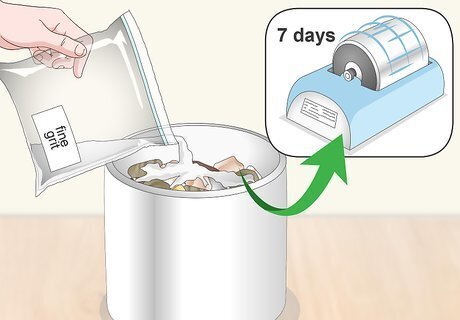
Tumble with fine grit for 7 days. Once again, place the clean rocks back in the tumbler, and add the same amount of fine grit as you did the coarse and medium. Pour in water until it touches the bottom of the top layer of rocks, then put the lid on and start the tumbling process. This cycle should take about 7 days, and as usual, you’ll check on the rocks’ progress every 24 hours. This is the last stage of using grit, so don’t cut the cycle short until you are happy with the smoothness and shininess of the rocks. You may need to clean a rock off to see the shine when you’re checking in on the rocks’ progress.

Clean the rocks and the tumblr and do a final polish. Thoroughly clean the rocks and the tumbler as usual, making sure to remove all the grit from the tumbler’s nooks and crannies. When you remove the grit from the rocks, you’ll see that they are brilliant and shiny! If some rocks need a bit more shine, dab a bit of rock polish onto a sheet of leather, then rub the rock against it. Make sure to polish the entire surface to get the brilliance that you want!



















Comments
0 comment